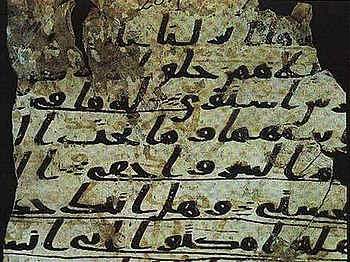Gerd R. Puin
Gerd Rüdiger Puin (born 1940) is a German scholar and an authority on Qur'anic historical orthography, the study and scholarly interpretation of ancient manuscripts. He is also a specialist in Arabic paleography. He was a lecturer of Arabic at Saarland University, in Saarbrücken Germany.
Sana'a Qur'an find

Gerd Puin was the head of a restoration project, commissioned by the Yemeni government, which spent a significant amount of time examining the ancient Qur'anic manuscripts discovered in Sana'a, Yemen, in 1972, in order to find criteria for systematically cataloging them. According to writer Toby Lester, his examination revealed "unconventional verse orderings, minor textual variations, and rare styles of orthography and artistic embellishment."[1] The scriptures were written in the early Hijazi Arabic script, matching the pieces of the earliest Qur'ans known to exist. Some of the papyrus on which the text appears shows clear signs of earlier use, being that previous, washed-off writings are also visible on it. In 2008 and 2009 Dr Elisabeth Puin published detailed results of the analysis of Sanaa manuscript DAM (dar al-makhtutat) 01.27-1 proving that the text was still in flux in the time span between the scriptio inferior and the scriptio superior of the palimpsest.[2][3]
More than 15,000 sheets of the Yemeni Qur'ans have painstakingly been cleaned, treated, sorted, cataloged and photographed and 35,000 microfilmed photos have been made of the manuscripts. Some of Puin's initial remarks on his findings are found in his essay titled the "Observations on Early Qur'an Manuscripts in San'a" which has been republished in the book What the Koran Really Says by Ibn Warraq.
Assessment of the Qur'an
In the 1999 Atlantic Monthly article referenced below, Gerd Puin is quoted as saying that: My idea is that the Koran is a kind of cocktail of texts that were not all understood even at the time of Muhammad. Many of them may even be a hundred years older than Islam itself. Even within the Islamic traditions there is a huge body of contradictory information, including a significant Christian substrate; one can derive a whole Islamic anti-history from them if one wants.[1]
The Koran claims for itself that it is 'mubeen,' or 'clear,' but if you look at it, you will notice that every fifth sentence or so simply doesn't make sense. Many Muslims—and Orientalists—will tell you otherwise, of course, but the fact is that a fifth of the Koranic text is just incomprehensible. This is what has caused the traditional anxiety regarding translation. If the Koran is not comprehensible—if it can't even be understood in Arabic—then it's not translatable. People fear that. And since the Koran claims repeatedly to be clear but obviously is not—as even speakers of Arabic will tell you—there is a contradiction. Something else must be going on.[4]
Written publications
- Ohlig, Karl-Heinz; Puin, Gerd-Rüdiger (2007). Die dunklen Anfänge. Neue Forschungen zur Entstehung und frühen Geschichte des Islam (in German) (3rd ed.). Berlin: Verlag Hans Schiler. ISBN 978-3-89930-128-1. LCCN 2006374620. OCLC 173644215.
{{cite book}}: Unknown parameter|trans_title=ignored (|trans-title=suggested) (help) - Ohlig, Karl-Heinz; Puin, Gerd-Rüdiger (2009). The hidden origins of Islam : new research into its early history (1st ed.). Amherst, NY: Prometheus Books. ISBN 978-1-59102-634-1. LCCN 2008049316. OCLC 179808111.
- Hans-Caspar Graf von Bothmer, Karl-Heinz Ohlig, Gerd-Rüdiger Puin (1999). "Über die Bedeutung der ältesten Koranfragmente aus Sanaa (Jemen) für die Orthographiegeschichte des Korans. In: Neue Wege der Koranforschung" (PDF, 0.4 MB). magazin forschung. 1999 (1). Saarland University: 37–40. ISSN 0937-7301.
{{cite journal}}: Unknown parameter|trans_title=ignored (|trans-title=suggested) (help)CS1 maint: multiple names: authors list (link)
See also
References
- ^
Lester, Toby (1999). "What Is the Koran?". Atlantic Monthly. ISSN 1072-7825. Retrieved 7 July 2012.
{{cite news}}: Unknown parameter|month=ignored (help) - ^
Puin, Elisabeth (2008). "Ein früher Koranpalimpsest aus Ṣanʿāʾ - I. Einführung [An early Quran palimpsest from Sana'a - I: Introduction]". In Markus Groß, Karl-Heinz Ohlig (ed.). Schlaglichter: Die beiden ersten islamischen Jahrhunderte (in German) (1st ed.). Berlin: Verlag Hans Schiler. pp. 461–. ISBN 978-3-89930-224-0. LCCN 2009379219. OCLC 299070399.
{{cite book}}: External link in|chapterurl=|chapterurl=ignored (|chapter-url=suggested) (help); Unknown parameter|trans_title=ignored (|trans-title=suggested) (help) - ^
Puin, Elisabeth (2009). "Ein früher Koranpalimpsest aus Ṣanʿāʾ - II. [An early Quran palimpsest from Sana'a - II. ]". In Markus Groß, Karl-Heinz Ohlig (ed.). Vom Koran zum Islam. Schriften zur frühen Islamgeschichte und zum Koran [Writings on the early Islamic history and on the Quran] (in German). Vol. 4 (1st ed.). Berlin: Verlag Hans Schiler. pp. 523–581. ISBN 978-3-89930-269-1. LCCN 2010359348. OCLC 496960079.
{{cite book}}: Unknown parameter|trans_title=ignored (|trans-title=suggested) (help) - ^
Lester, Toby (1999). "What Is the Koran?". Atlantic Monthly. ISSN 1072-7825. Retrieved 7 July 2012.
{{cite news}}: Unknown parameter|month=ignored (help)
- Puin, Gerd-R. (1996). "Observations on Early Qur'an Manuscripts in Ṣanʿāʾ". In Stefan Wild (ed.). The Qur'an as Text. Leiden, Netherlands: E. J. Brill. pp. 107–111. ISBN 978-90-04-10344-3. LCCN 95030502. OCLC 243818821.
{{cite book}}: External link in|chapterurl=|chapterurl=ignored (|chapter-url=suggested) (help) Reprinted in What the Koran Really Says, ed. Ibn Warraq, Prometheus Books, 2002, ISBN 978-1-57392-945-5.
